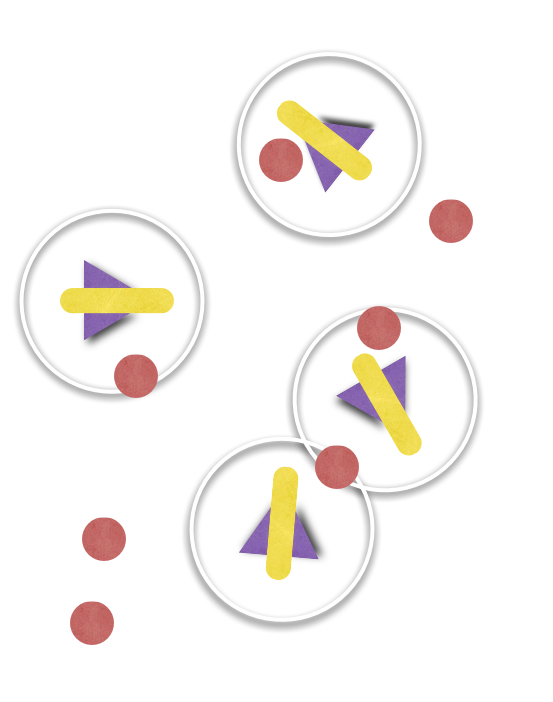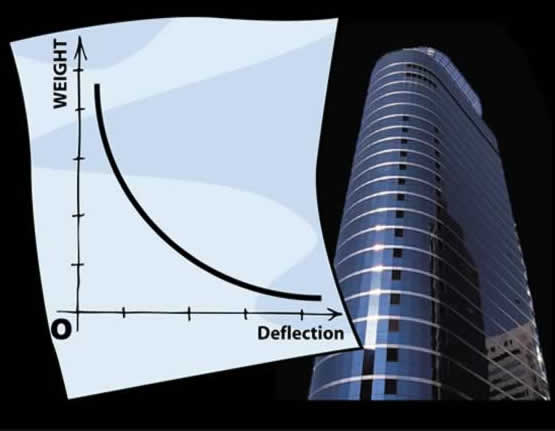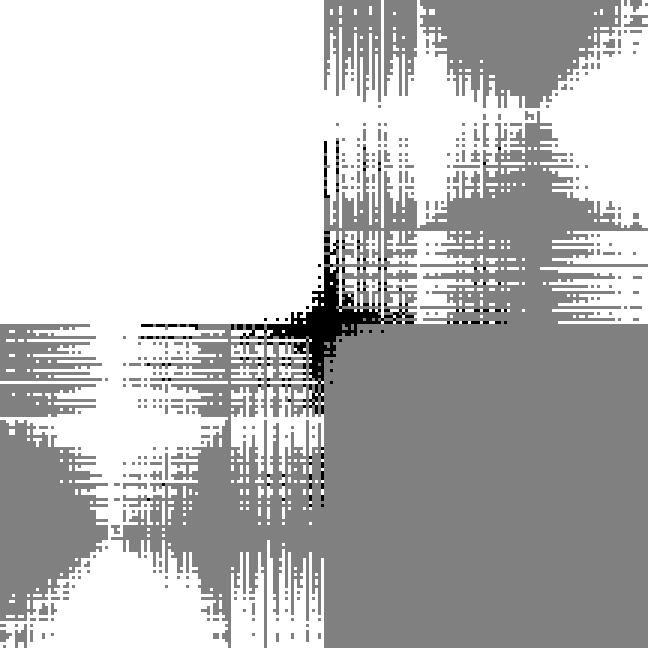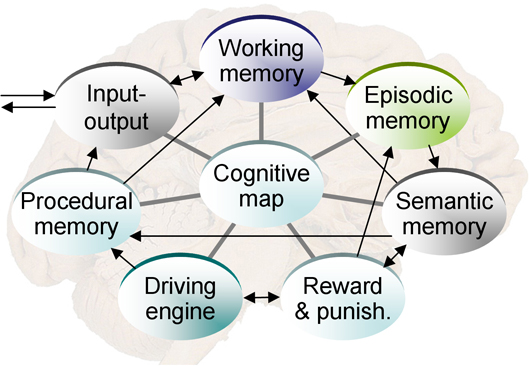

| home | people | publications | tools | research | activities | community |
EC lab Research
This page contains projects of past, present or future interest for members of the EC lab.Inter-Agent Communication Using Pheromones
 |
This project investigates the use of pheromones (inspired from ant colonies) for inter-agent communication. While foraging, ants and termites use pheromones to mark the trails to food locations and to recruit other ants into foraging from specific locations. Similarly, agents in simulation (or, why not!, controlling real robots) can mark the environment in order to store information about past experiences and to also share this knowledge with peer agents. A first problem domain of interest concerns foraging, where the task consists of locating a source of food and carrying as many food items as possible to the original location (nest) . Our approach allows for the presence of obstacles in the initially unknown terrain. We envision taking this project further by allowing agents to specialize for specific tasks such as patrolling, nest and trail defense, scouting or carrying. We also already started experimenting with learning approaches (Evolutionary Computation!) for the emergent foraging behavior.
Most of the work on this project has been done in the new
MASON system; learning approaches
were implemented in the ECJ system.
For more information on the project, please visit the unofficial
homepage of the project, or
contact Liviu Panait or Dr. Sean Luke. |
Micro Air Vehicles (MAVs)
|
Micro Air Vehicles represent a potentially cheaper and scalable solution to a single costly airplane for different military operations. A set of such small flying vehicles can potentially perform the same set of tasks as a single high-tech airplane, but they also add robustness to failure into the solution. Repeated and unpredictable interactions among such autonomous vehicles, combined with the emergence of new complex behaviors from simpler ones, usually hamper the task of programming the behaviors of the simpler agents to the point where it is really unrealistic to even try doing so. For this reason, we decided to employ learning techniques (Evolutionary Computation!) for the task of automatically finding good performing team behaviors in cooperative surveillance domains. |
 |
Capital Budgeting and Resource Allocation Methodology for Critical Infrastructure Protection
 |
This project was sponsored by the National Capital Region (NCR). Its goal was to develop a methodology which would support decision-makers in making choices on optimal resource allocation for critical infrastructure protection. The project established a set of metrics that can be used to measure the benefits associated with the programs to mitigate identified vulnerabilities of critical infrastructure systems. It also specified models that can be used to estimate the values of these metrics and their distribution across sectors and stakeholders in the Region. In order to achieve it, decision analytic methods were employed to quantify their relative importance and to prioritize alternative mitigation programs. As a part of the delivarables of the project a multiobjective optimization model for resource allocation was developed. It was implemented in a computer system called Emergent Designer and solved using evolutionary multiobjective algorithms. This model can recommend sets of mitigation programs for funding that maximize the benefit realized, and subject to constraints on cost and other resources For more information on this project, please contact Dr. Rafal Kicinger or Dr. Andrew Loerch. |
Multiobjective Structural Design
|
This project investigates the use of evolutionary multiobjective algorithms in structural design. The subject of multiobjective design are steel structural systems in tall buildings which belong to the class of most complex problems in structural engineering. The project is a joint effort of researchers from George Mason University and Tohoku University, Sendai, Japan. Traditionally, steel structural systems in tall buildings were optimized with respect to a single criterion (usually cost or the total weight) while satisfying constraints on maximal strains/stresses, maximal defelctions, etc. In this project we extend this approach by investigating quantitative and qualitative changes in optimal topologies of structural systems when both the total weight and the maximum displacement of a tall building are treated as equally important objectives. This approach resulted in additional insights into the structure of this complex design problem and provided a broader perspective on the trade-offs involved. For more information on the project, please contact Dr. Rafal Kicinger. |
 |
Engineering Education: Personal Air Vehicles
 |
This project was an effort of George Mason University researchers working with NASA to develop enhanced education and training environments of future aerospace workforce. GMU is a member Hierarchical Learning Network, a consortium of universities cooperating with NASA Langley Research Center. The research had two major interrelated components. The first component was the development of a novel methodology for building intelligent tutoring systems utilizing state-of-the-art computer science, including the technology of intelligent agents. The second component was actually building a tutoring system based on the developed methodology to demonstrate its feasibility. The propotype was build for the domain of personal air vehicles. For this prototype system, state-of-the-art technology in the area of personal air vehicles has been analyzed with the help of NASA experts. The acquired knowledge was structured into an ontology using the ontology editor Protege. Assessment and refinement of the knowledge base was conducted in cooperation with NASA. Subsequently, a Macromedia environment was used to integrate various pieces of the tutoring system. A Macromedia JRun web application server was used to communicate with Protege through the Java environment and to provide an interactive interface between the user and the knowledge base. The graphical user interface was developed using Macromedia Flash and integrated with Macromedia JRun. The shell was integrated with the ontology and with other parts of the system. A working demo of the system was developed and presented to the NASA and Old Dominion University engineering experts in February, 2003. For more information on the project, please visit the project homepage, or contact Dr. Rafal Kicinger or Elena Popovici. |
Analysis of Island Models
|
Island models in Evolutionary Computation are models in which
multiple populations evolve on their own and sporadically exchange
information by sending migrants. Such models not only allow for
distribution of computation on many machines, but also behave
qualitatively differently.
This project aims at a deeper understanding of the behavior of island
models. The first part of experiments has a goal of analyzing the
relations between various parameters of island models and assessing
their mutual importance. Some results were published in a GECCO
2005 paper. |
 |
Assessment of Water Network Vulnerability
 |
The aim of this project was to find vulnerabilities in the water network of a size of a small town. We used an artificial network designed specially for this purpose. We studied both the impact of possible contaminant spread in the system, as well as effects of breaking (and cutting off) pipes on the system pressure. Assuming the possibility of a malicious attack, we used coevolution to design possible security scenarios. These evolved counter-measures often turned out better than manually designed security plans. For more information on the project, please contact Zbigniew Skolicki or Dr. Tomasz Arciszewski. |
Analysis of Concurrent Learning
|
Previous research has highlighted a tendency for concurrent learners to converge to suboptimal solutions due to coadaptation. We conduct analysis of concurrent learning methods to understand how to minimize the negative effects of coadaptation onto the search. We employ different theoretical frameworks of concurrent learning (such as the EGT model) to study mathematical models of these algorithms, to understand under what conditions they can be guaranteed to find the optimal solution, and to visualize the basins of attraction when using different approximations of such mathematical models. We also aim to apply our theoretical understanding of concurent learning to create novel, better algorithms (such as Biased CCEA, oCCEA and Lenient Multiagent Reinforcement Learning). For more information on the project, please contact Liviu Panait. |
 |
Integrated Self-Aware Cognitive Architecture
 |
This project will introduce a general cognitive architecture that will allow for a computational implementation of the key features of human cognition, including examples like basic human memory systems (working, semantic, episodic, procedural), the autonomous cognitive growth ability, social, emotional and communicational capabilities, and self-awareness. According to our view, the key element enabling these features in an intelligent agent is the Self of the agent, understood as neither the hardware nor the software, but an idealized abstraction represented in the agent's mind. Our approach to implementation of this Self is based on four building blocks: (1) neuromorphic cognitive map, (2) a set of self axioms, (3) mental state lattice, (4) the framework of schemas that generalize productions, operators and chunks used in popular cognitive architectures like Soar, Act-R and Epic. In addition, we suggest a mapping of our cognitive architecture onto brain structures. This mapping helps us to borrow computational and design principles from cognitive neuroscience. For more information on the project, please contact Mark Coletti or Drs. Alexei V. Samsonovich, Kenneth A. De Jong, Giorgio A. Ascoli. |

| home | people | publications | tools | research | activities | community |